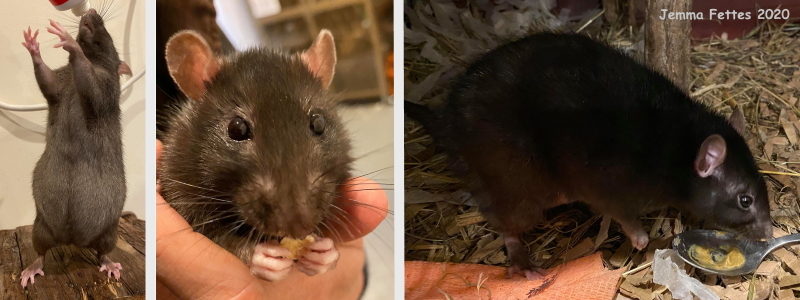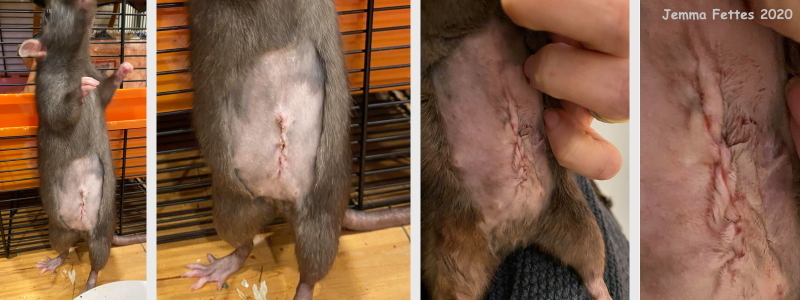Figure 4: Preeclampsia in an 8-month-old pregnant female rat (Twizzel).
Case history and photos
History
Twizzel was a fit, healthy, 8-month-old doe, who was mated at the younger end of the normal mating window for this breeder’s (and owner) lines. The pregnancy was fairly normal, although she gained obvious weight earlier in the pregnancy than expected, and it was clear that the litter was going to be large (average litter size is around 8 babies in this line, a big litter counts 11-13 babies, the largest litter to date counted 15 babies).
Around day 19 of the pregnancy (counting the morning after mating as day 1) Twizzel was moved into a birthing cage with a friendly cagemate, as she was massive and clearly struggling to get around (normally this wouldn’t have been done until day 21). She was still active and behaving friendly, just cumbersome. On the evening of day 20 she seemed a bit quiet, however this isn’t uncommon approaching birth, so the behavior was put down to her simply being a bit uncomfortable and the birth was expected by day 22 (normal for this line is birthing on day 22-23, occasionally day 24).
Clinical Signs
The following morning (day 21) Twizzel was clearly not well. She sat hunched, with piloerect fur, was squinting, displayed rapid panting breathing, showed decreased interest in food, and displayed jerky neurological-looking symptoms when tempted with a food she normally loved. Her body temperature was normal to touch, however she was limp and her breeder felt something was very wrong.
Twizzel was immediately taken to the vet, who agreed it was an emergency.
Diagnosis
Preeclampsia
Treatment
The vet performed an ultrasound to determine if the babies were still alive (they were). Twizzel was given a calcium and subcutaneous fluid injection, as well as oral paracetamol. No blood pressure altering medication was administered, since the vet was unable to check Twizzel’s blood pressure and did not want to risk decreasing it below normal threshold. At this point Twizzel was taken home for a couple of hours, with instructions to monitor her for improvement.
During this time Twizzel’s breeder contacted several other breeders having experience with preeclampsia in their rats (it is unfortunately fairly common in British/American blue lines in the UK). They informed this breeder that calcium injections rarely have an effect on preeclampsia in rats and, although the chance of a positive outcome was slim, advised an emergency spay. In the meantime, Twizzel had not shown any improvement, if anything she appeared a bit worse, “more flat in her body”. The vet agreed that an emergency cesarean and spay were necessary, and it was agreed upon that, while they would try to revive the babies, Twizzel’s life came first. (Note that there was a potential foster mum available, as one of the breeders’s other female rats had given birth the previous night.)
Outcome
The spay was successful and, although Twizzel was slow to respond postop, she did come around reasonably well. After the surgical recovery period she was significantly more aware and alert, albeit a little “dopey” from the opioids that this vet uses as standard practice during surgeries. Her breathing was still heavy and a little harsh, but her condition had significantly improved compared to that morning. She was put on a course of antibiotics as well as medication for pain relief.
Twizzel’s litter was indeed very large, consisting of 18 babies in total. The vet was able to revive several of them, however only one maintained breathing. The foster mum accepted this baby without any trouble. However, sadly he was clearly premature and not strong enough to feed, and passed away a couple of hours later.
Follow-up
Nearly a week after the spay Twizzel was doing very well and back to her active self, although her body did initially take longer to recover than it would have from a regular spay. The incision site (significantly larger than in a regular spay) was healing well. All breathing irregularities as well as her appetite had recovered to normal within 24 hours after the surgery.
(Twizzel continues to do well and doesn’t appear to be suffering from any long term effects from the condition.)
Photos and Videos
Video shows Twizzel day 21 of pregnancy beginning to show distress.

Row 01: The photograph on the left shows Twizzel on day 20 of her pregnancy; note the clearly enlarged abdomen. The following two photographs show Twizzel recovering immediately after the emergency cesarean and spay. |

Row 02: These two photograph (each with a close-up) were taken on day 5 after Twizzel’s surgery and show the incision site. |
This video shows Twizzel recovering following the surgery.
—
Case history, photos and videos courtesy of Jemma Fettes
Case compilation courtesy of Cyzahhe
Case editing courtesy of Karen Grant RN and Cyzahhe


